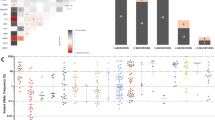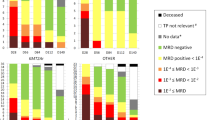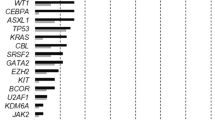Abstract
Myeloid leukemia of Down syndrome (ML-DS) is associated with good response to chemotherapy, resulting in favorable outcomes. However, no universal prognostic factors have been identified to date. To clarify a subgroup with high risk of relapse, the role of minimal residual disease (MRD) was explored in the AML-D11 trial by the Japanese Pediatric Leukemia/Lymphoma Study Group. MRD was prospectively evaluated at after induction therapy and at the end of all chemotherapy, using flow cytometry (FCM-MRD) and GATA1-targeted deep sequencing (GATA1-MRD). A total of 78 patients were eligible and 76 patients were stratified to the standard risk (SR) group by morphology. In SR patients, FCM-MRD and GATA1-MRD after induction were positive in 5/65 and 7/59 patients, respectively. Three-year event-free survival (EFS) and overall survival (OS) rates were 95.0% and 96.7% in the FCM-MRD-negative population, and 60.0% and 80.0% in the positive population. Three-year EFS and OS rates were both 98.1% in the GATA1-MRD-negative population, and 57.1% and 71.4% in the positive population. Adjusted hazard ratios for associations of FCM-MRD with EFS were 14.67 (p = 0.01). Detection of MRD by either FCM or GATA1 after initial induction therapy represents a significant prognostic factor for predicting ML-DS relapse.
This is a preview of subscription content, access via your institution
Access options
Subscribe to this journal
Receive 12 print issues and online access
$259.00 per year
only $21.58 per issue
Buy this article
- Purchase on Springer Link
- Instant access to full article PDF
Prices may be subject to local taxes which are calculated during checkout




Similar content being viewed by others
Change history
01 September 2021
A Correction to this paper has been published: https://doi.org/10.1038/s41375-021-01397-w
References
Uffmann M, Rasche M, Zimmermann M, von Neuhoff C, Creutzig U, Dworzak M, et al. Therapy reduction in patients with Down syndrome and myeloid leukemia: the international ML-DS 2006 trial. Blood .2017;129:3314–21.
Taub JW, Berman JN, Hitzler JK, Sorrell AD, Lacayo NJ, Mast K, et al. Improved outcomes for myeloid leukemia of Down syndrome: a report from the Children’s Oncology Group AAML0431 trial. Blood .2017;129:3304–13.
Taga T, Watanabe T, Tomizawa D, Kudo K, Terui K, Moritake H, et al. Preserved high probability of overall survival with significant reduction of chemotherapy for myeloid leukemia in Down syndrome: a nationwide prospective study in Japan. Pediatr Blood Cancer. 2016;63:248–54.
Taga T, Saito AM, Kudo K, Tomizawa D, Terui K, Moritake H, et al. Clinic al characteristics and outcome of refractory/relapsed myeloid leukemia in children with Down syndrome. Blood. 2012;120:1810–5.
Gamis AS, Woods WG, Alonzo TA, Buxton A, Lange B, Barnard DR, et al. Increased age at diagnosis has a significantly negative effect on outcome in children with Down syndrome and acute myeloid leukemia: a report from the Children’s Cancer Group Study 2891. J Clin Oncol. 2003;21:3415–22.
Blink M, Zimmermann M, von Neuhoff C, Reinhardt D, de Haas V, Hasle H, et al. Normal karyotype is a poor prognostic factor in myeloid leukemia of Down syndrome: a retrospective, international study. Haematologica. 2014;99:299–307.
Rubnitz JE, Inaba H, Dahl G, Ribeiro RC, Bowman WP, Taub J, et al. Minimal residual disease-directed therapy for childhood acute myeloid leukaemia: results of the AML02 multicentre trial. Lancet Oncol. 2010;11:543–52.
Xu G, Nagano M, Kanezaki R, Toki T, Hayashi Y, Taketani T, et al. Frequent mutations in the GATA-1 gene in the transient myeloproliferative disorder of Down syndrome. Blood .2003;102:2960–8.
Kanezaki R, Toki T, Terui K, Xu G, Wang R, Shimada A, et al. Down syndrome and GATA1 mutations in transient abnormal myeloproliferative disorder: mutation classes correlate with progression to myeloid leukemia. Blood. 2010;116:4631–8.
Terui K, Toki T, Taga T, Iwamoto S, Miyamura T, Hasegawa D, et al. Highly sensitive detection of GATA1 mutations in patients with myeloid leukemia associated with Down syndrome by combining Sanger and targeted next generation sequencing. Genes Chromosomes Cancer. 2020;59:160–7.
Loken MR, Alonzo TA, Pardo L, Gerbing RB, Raimondi SC, Hirsch BA, et al. Residual disease detected by multidimensional flowcytometry signifies high relapse risk in patients with de novo acute myeloid leukemia:a report from Children’s Oncology Group. Blood 2012;120:1581–8.
Kudo K, Kojima S, Tabuchi K, Yabe H, Tawa A, Imaizumi M, et al. Prospective study of a pirarubicin, intermediate-dose cytarabine, and etoposide regimen in children with Down syndrome and acute myeloid leukemia: the Japanese Childhood AML Cooperative Study Group. J Clin Oncol. 2007;25:5442–7.
Al-Ahmari A, Shah N, Sung L, Zipursky A, Hitzler J. Long-term results of an ultra low-dose cytarabine-based regimen for the treatment of acute megakaryoblastic leukaemia in children with Down syndrome. Br J Haematol. 2006;133:646–8.
Nakashima K, Hasegawa D, Tomizawa D, Miyamura T, Hama A, Iwamoto S, et al. Characteristics and outcomes of children with acute myeloid leukemia and Down syndrome who are ineligible for clinical trials due to severe comorbidities. Pediatr Blood Cancer. 2019;66:e27942 https://doi.org/10.1002/pbc.27942
Acknowledgements
The authors deeply appreciate the invaluable cooperation of the large number of physicians working at the institutions, central diagnostic laboratories, and the office and data center of the JPLSG. We also wish to thank Dario Campana and Elaine Coustan-Smith (National University of Singapore) for helpful discussions regarding FCM-MRD analysis. This work was supported by a Grant for Clinical Cancer Research and a Grant-in-Aid for Cancer Research from the Ministry of Health, Labour, and Welfare of Japan. This work was supported in part by the Project Promoting Clinical Trials for Development of New Drugs (JP19lk0201061t0004) and Practical Research for Innovative Cancer Control (JP19ck0106329) from the Japan Agency for Medical Research and Development (AMED) and by Grants-in-Aid for scientific research from the Ministry of Education, Culture, Sports, Science, and Technology of Japan (KAKENHI: 26253061, 18H04039).
Author information
Authors and Affiliations
Contributions
T.Tag (principal investigator), Daisuke H, TM, YH, HM, HN, HT, AS, and DT participated actively in the study conception and design; Ta.Ta., ST, Daisuke H, and DT reviewed the data analysis and interpretation and were the main authors of the paper; AMS and ST conducted the statistical analyses; SI and HH were responsible for immunodiagnostics and FCM-MRD analysis; KT, EI, and T.Tok were responsible for GATA1 mutation and GATA1-MRD analysis; T.Tak was responsible for coordinating the molecular biological analyses; AH was responsible for diagnosis and treatment response by morphology; MI was responsible for diagnosis by pathology; KK, Daiichiro H, and AH recruited patients; and Ta.Ta., ST, and SA contributed financial and administrative support for the study. All authors contributed to the conduct of the trial and were involved in the review of the results and the final approval of the paper.
Corresponding author
Ethics declarations
Conflict of interest
The authors declare no competing interest.
Additional information
Publisher’s note Springer Nature remains neutral with regard to jurisdictional claims in published maps and institutional affiliations.
Supplementary information
Rights and permissions
About this article
Cite this article
Taga, T., Tanaka, S., Hasegawa, D. et al. Post-induction MRD by FCM and GATA1-PCR are significant prognostic factors for myeloid leukemia of Down syndrome. Leukemia 35, 2508–2516 (2021). https://doi.org/10.1038/s41375-021-01157-w
Received:
Revised:
Accepted:
Published:
Issue Date:
DOI: https://doi.org/10.1038/s41375-021-01157-w



